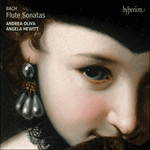The Sonata in E minor for flute and continuo, BWV1034, is probably a product of Bach’s early Leipzig years. Bach’s autograph of the piece is lost but the earliest surviving material dates from circa 1726. Perhaps the first-composed of his flute sonatas, it alludes to the older formal scheme of the Italian sonata ‘da chiesa’. The opening ‘Adagio ma non tanto’ contains an expansive, pleasingly shaped melody in a single unrepeated section. The following ‘Allegro’ derives interest and energy from a progression of arpeggios of a kind favoured by Venetian violinist-composers. The emphasis in this movement is on virtuosity, though never for its own sake. The melody of the lyrical ‘Andante’ is anchored to an almost uninterrupted quaver accompaniment in the bass betraying, once more, strong Italian leanings. The highly motivated concluding ‘Allegro’ is binary and introduced by a single crotchet in the bass. Like the second movement, this one requires technical virtuosity.
from notes by Nicholas Anderson © 2002
La Sonate en mi mineur pour flûte traversière et continuo, BWV1034, a probablement été composée par Bach peu après son arrivée à Leipzig. L’autographe est perdu, mais les copies les plus anciennes qui nous sont parvenues datent d’environ 1726. C’est sans doute la première de ses sonates pour flûte à avoir été composée, et elle renvoie à l’organisation formelle ancienne de la sonata «da chiesa» (sonate d’église) italienne. L’«Adagio ma non tanto» initial fait entendre une ample et plaisante mélodie en une seule section, sans reprise. Une progression en arpèges caractéristique des violonistes-compositeurs vénitiens confère intérêt et énergie à l’«Allegro» suivant, qui met l’accent sur la virtuosité, mais jamais en tant que virtuosité pure. L’«Andante», lyrique, ancre sa mélodie dans un accompagnement presque ininterrompu de croches à la basse, trahissant une fois de plus une forte influence italienne. Riche en motifs, l’«Allegro» final, binaire, est introduit par une seule noire à la basse. Comme le deuxième mouvement, il requiert une grande virtuosité technique.
extrait des notes rédigées par Nicholas Anderson © 2002
Français: Josée Bégaud
Die Sonate in e-Moll für Flöte und Basso continuo, BWV1034, ist wahrscheinlich ein Produkt aus Bachs frühen Leipziger Jahren. Bachs Manuskript dieses Stücks ging verloren, aber das früheste noch erhaltene Material stammt aus der Zeit um 1726. Dieses Werk, das vielleicht die erste von ihm komponierte Flötensonate ist, spielt auf das ältere Formschema der italienischen „Sonata da chiesa“ an. Die Eröffnung „Adagio ma non tanto“ enthält in einem einzelnen, nicht wiederholten Abschnitt eine ausgedehnte, hübsch gestaltete Melodie. Das dann folgende „Allegro“ zieht sein Interesse und seine Energie aus einer fortschreitenden Reihe von Arpeggios der Art, wie sie von venezianischen violinespielenden Komponisten bevorzugt wurde. Die Betonung in diesem Satz liegt auf Virtuosität, jedoch ist diese nie Selbstzweck. Die Melodie des lyrischen „Andante“ ist in einer fast ununterbrochenen Achtelnoten-Begleitung im Bass verankert, was wiederum auf eine starke Neigung zur italienischen Musik hinweist. Das mit vielen Motiven durchzogene Schlussallegro ist zweiteilig und wird durch eine einzelne Viertelnote im Bass eingeleitet. Wie der zweite Satz erfordert auch dieser technische Virtuosität.
aus dem Begleittext von Nicholas Anderson © 2002
Deutsch: Atlas Translations


 Bach: Flute Sonatas
Bach: Flute Sonatas
